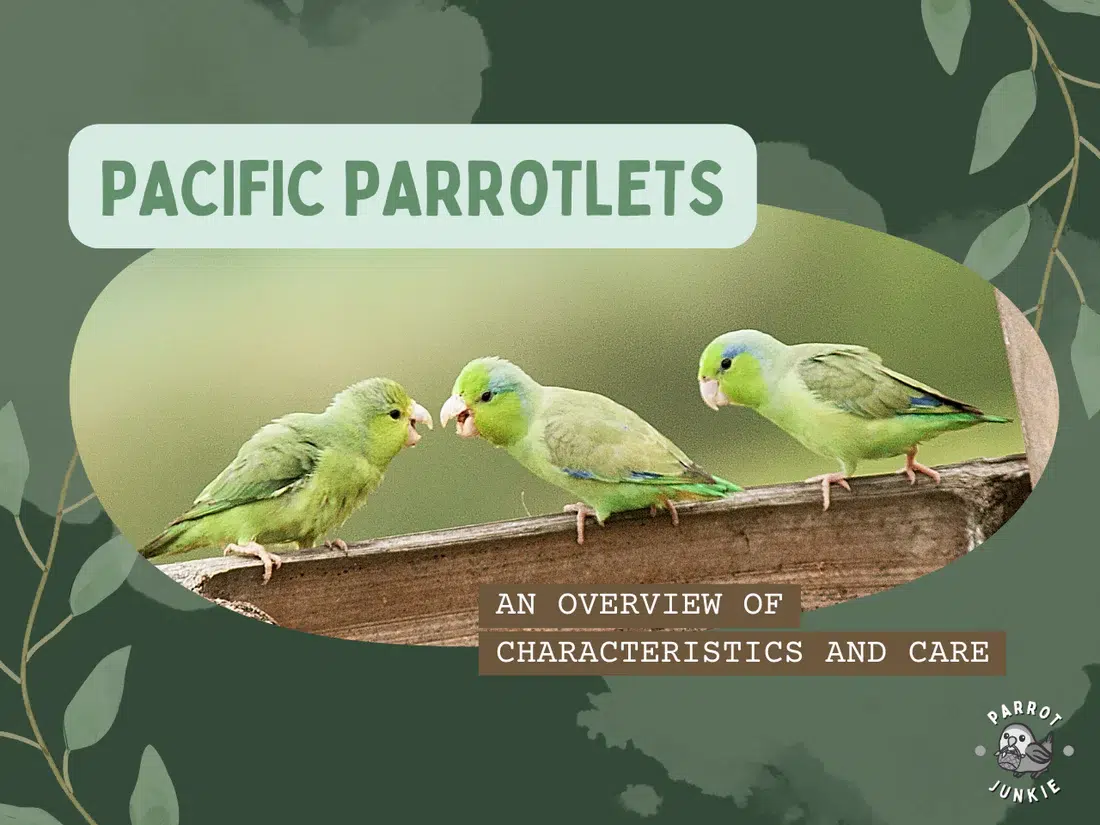
Pacific Parrotlets – An Overview of Characteristics and Care
Commonly mistaken as lovebirds or tiny Amazon parrots, don’t be fooled by their tiny appearance! Pacific parrotlets (Forpus coelestis) are charming, active, and curious, with the species becoming increasingly popular due to their small “pocket” size and ability to learn tricks.
Parrotlets are the second smallest parrots in the world, and are close relatives to the Amazon parrot, with the species commonly found in the wild in the Andes, western Ecuador, and northern Peru. These little guys are no bigger than 5 inches and often weigh around 30 grams, often spouting a wedged-shaped tail and large beaks in comparison to their small size.
Jump To Section

Parrotlets’ Personality As Pets
Out of the entire parrotlet species, the Pacific parrotlet is known to be the most feisty and outgoing among the rest of its counterparts. However, Pacific parrotlets can hold a strong bond with their owners and are easily trainable and highly intelligent, despite their petite size. Due to their feisty nature, pacific parrotlets are generally not recommended as a family pet for children or young kids, as their strong personalities and stubbornness can lead them to be nippy and territorial, especially when they are not handled frequently.
Hence, It is recommended that potential are aware of their active and feisty nature, which will need frequent training and handling to maintain their tameness. When limits and boundaries are enforced during frequent handling and training, parrotlets can be wonderful and loving pets to their owners.
The Lifespan of Pacific Parrotlets
Owning a pet is a long-term commitment, especially with birds. Pacific parrotlets average 15-20 years in terms of life span, with some even living up to the age of 30. Hence, before deciding on whether you should get a parrotlet as a pet, it is always good to consider your ability to commit to caring for a bird that will require many years of care, housing, vet fees and checkups, food, and enrichment.
Gender Sexing of Pacific Parrotlets
Parrotlets are sexually dimorphic and can be easily sexed through visual observation. In the wild, males of the Pacific parrotlet species don cobalt blue streaks and coloration on their wings, behind the eyes, and on their rumps. While captive-bred parrotlets come in many different color variations, males should always have the cobalt blue markings on the flight wings, with exceptions being heavily pied mutations and lutino/albino birds.
Females on the other hand lack the cobalt blue coloration at the covert feathers on the flight wings but may have the same distinct shade of blue behind their eyes and on their rump. To sex a parrotlet accurately, the cobalt blue must be present on the covert feathers on the flight wings for the bird to be considered a male.
Cage Requirements of Parrotlets
Despite their small physiques, parrotlets need an appropriate-sized cage that allows for free movement and flight. The cage should minimally be 18″x18″ (46cm x 46cm), though it is generally recommended that you opt for the largest cage that you can afford.
Potential owners will also have to keep in mind the bar spacings and ensure that they are no bigger than ½ inches (1.3cm) in gap space. This is to prevent the bird from getting their heads or bodies stuck between the bar spacings. Wider cages are also better in comparison to tall cages as this allows for natural movement for the birds.
Pacific Parrotlets’ Dietary Needs
A good and healthy diet is an absolute necessity when it comes to birds. In the wild, Pacific parrotlets often feast on grass seeds and fresh fruit during the different seasons. It is recommended that you feed your parrotlet a varied diet rich in nutrients which consists of a high-grade pellet (cold-press pellets are recommended for this breed of bird), a high-quality seed mix, fresh chop (mixture of fresh vegetables), fresh fruits, wholemeal pasta, sprouts, legumes, and whole grains. Fresh and clean water should also be accessible to your parrotlet at all times.
While some owners may like to portion out the different foods to ensure that they maintain a specific proportion of pellets, seeds, and fresh foods, it is good to take note that seeds and nuts are a must for parrotlets due to their high metabolism rates. Hence, seeds should be accessible to them throughout the day to ensure that they are getting the essential oils and fats that they need to maintain a healthy plumage and an active lifestyle.
For owners with freshly weaned babies, an introduction to a varied diet of fresh veggies, fruits, and pellets should be done from the very start at an early age. This is to prevent your parrotlet from developing any pickiness when it comes to consuming fresh vegetables, fruits, or pellets.
Cage Mates
If you are considering housing your Pacific parrotlet with other birds, regardless of whether it is with fellow parrotlets or a different bird species, here are some pointers to take note of.
With other bird species:
Parrotlets should be kept strictly alone in a single cage. Do not house parrotlets with other bird species as they will attack and even kill birds that are bigger than them in size. To ensure the safety of all birds, ensure that the parrotlet is housed separately and away from other birds if it is displaying aggressive and territorial behavior.
With other parrotlets:
While parrotlets in the wild can be found in flocks of up to 50 at any one point, captive-kept parrotlets do best as a single pet bird. Due to their territorial and aggressive nature, especially during hormonal seasons, one parrotlet should be strictly kept to one cage at all times.
Owners who wish to house bonded pairs must ensure that the cage is sufficiently large and is filled with ample space for the birds to fly around. This is to ensure that any bird can flee safely to another location during a fight. To avoid the risk of injury caused by a fight, it is still recommended that the housing situation remains at one parrotlet to one cage.
Training and Activities
Parrotlets are highly intelligent and inquisitive, with even the ability to mimic and speak. To ensure that your parrotlet is getting the mental stimulation and enrichment that they need to thrive in your home, one must ensure that there are enough shreddable toys (sola wood, mahogany wood pieces, pine wood, etc), perches ( natural wood only and must be secured to the cage) and swings to ensure that they are engaged, kept busy, and active in their cage.
Foraging baskets are also a favorite for many parrotlets and can be altered to allow them to practise their natural foraging behavior in the wild, such as hiding millet or their favorite treats for them to find.
Conclusion
Despite their small size, Pacific parrotlets require a conscientious amount of care and should not be taken lightly as pets. Regardless, they are known to form strong bonds with their owners, and can be great companions to us humans! If you plan to have a Pacific parrotlet as a pet, be sure to understand more about the species so that you can give it the best care it deserves.
Parrot Junkie www.parrotjunkie.com
Copyright © 2021-2024. All rights reserved.



Be the first to leave a comment